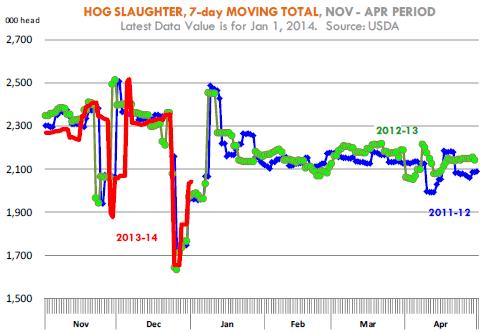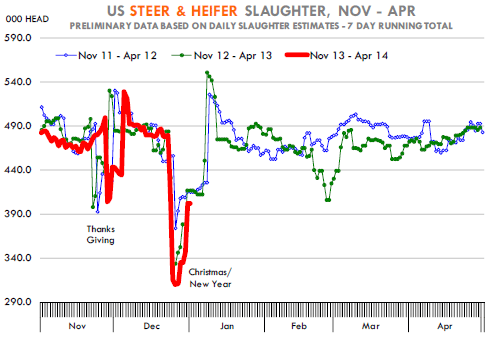



CME: Hog, Cattle Numbers Forecast to Return to Normal by Mid-January
US - Following a couple of holiday shortened weeks, cattle and hog number should return to a more normal pattern by the middle of January, write Steve Meyer and Len Steiner.From a seasonal perspective, the decline in hog numbers is more significant. Weekly slaughter is expected to go from around 2.3 million head/week in November and December to about 2.1 million head in January and February.
The latest Hogs and Pigs report indicated that hog supplies for the next six weeks should be running slightly below year ago levels. The inventory of hogs 180 pounds and over was pegged at 11.838 million head, 0.3 per cent lower than the previous year. These are hogs that normally come to market between 1 December and mid-January.
In the first four weeks of December hog slaughter was 8.835 million head, 0.9 per cent higher than a year ago. When you adjust for the difference in marketing days, however, the hog numbers appear to be in line with year ago levels.
The inventory of hogs 120-179 pounds was also pegged at about the same level as last year, which implies that weekly hog supplies will likely run at around 2.1 MM head (2013 levels). What about the impact of PEDv? Well, the hogs coming to market in January and February were likely affected by the PEDv cases last summer.
It remains to be seen whether the numbers coming to market belie the latest inventory survey. At this point, futures markets continue to remove some of the risk premiums built onto the nearby contracts while at the same time maintaining the premiums in the summer and fall market.
One factor to keep an eye on is the explosion in hog weights. Hog weights tend to be heavy into year end on slower marketings. So far, hog weights are running about 3 per cent above year ago levels. This kind of increase is bringing more pork to market despite flat growth in hog numbers. Heavy weighted have pressured pork prices lower.
Seasonality also has caught up with the pork market as ham prices have declined dramatically, as they normally do at this time of year. Ham prices normally are weak in January as well and a later Easter this year means that retailers will not be in a big hurry to accumulate hams in the next few weeks.
Loin and belly prices need to move up in order to support the cutout and futures will pay close attention to those items for any sign of weakness. Producers are trying to cope with the heavy weights and any slowdown in slaughter due to poor margins could be bearish for hog prices in the short term.

Cattle numbers are expected to be limited in Q1 of 2014, consistent with the cattle on feed inventories and the fact that the marketing window for summer cattle was skewed towards bringing cattle to market earlier than normal.
The expectation still is that fed cattle supplies should drift lower by late January and February. Beef demand remains key, however. Last year, packers struggled with poor orders during the winter and early spring, and eventually that led to a sharp drop in the prices paid for cattle.
Recently futures were buoyed by reports that packers paid over $134/cwt for cattle in the cash market. The choice cutout also appears poised to move over $200/cwt, a necessary threshold considering February futures are priced at around $134.6/cwt. With steak items seasonally lower in January, the cutout has been sustained so far by very strong gains for round cuts.
The test for the beef complex will come in mid January, a time when retailers have filled the meat case. If consumers balk at paying higher prices for beef, retailers will not be as aggressive on their bids. And as round cuts go this time of year so will the cutout.









